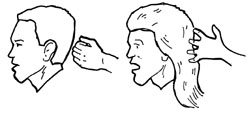WEAPONS AND COMBAT TECHNIQUES
At least fifteen or twenty of them; men, women, children. We opened up at seventy, maybe eighty meters. I could see chunks of flesh blasting off their bodies. Our rounds were hitting their mark! They kept coming, they just kept coming! I sighted one and let go a full burst from my BXP. I know I snapped his spine, because the man dropped like a leaf. Legs still twitching, he kept crawling after me! At twenty meters, we opened up with the Vektor. Nothing! I watched bits of organ and bone blown out their backs. I watched limbs literally sawed off at the joints. The SS77 is the best MG ever made, 840 meters per second, 800 rounds per minute, and it wasn’t doing a goddamn thing! What grenades we had only downed one of them. One! His mangled body lay motionless with a still-snapping head! [Name Withheld] let go with his RPG. The damn rocket went right through its soft target and took out a rock behind it! Finally, at five meters, we used the last bit of fuel in the flamethrower! The sons of bitches lit up like torches but just wouldn’t stop! One of them grabbed [Name Withheld], setting him on fire as it bit through his neck. I saw the rest of those things surround him as we took off for the jungle, a mob of burning bodies squatting down to tear another screaming human torch apart. Goddamn the devil’s mother, what the hell were we supposed to do!?!
—SERBIAN MERCENARY DURING THE ZAIRIAN CIVIL WAR, 1994
Choosing the right weapons (never carry just one) can make the difference between a pile of dead zombies and becoming one yourself. When confronted with the undead, it is easy to believe in the super-commando strategy: Load up with the heaviest, most powerful weapons possible and go out to “kick ass.” This is not only foolish—it is suicidal. Zombies are not camp guards in some POW escape movie, crumbling en masse with the first theatrical volley. Arming yourself for a zombie encounter requires careful consideration, a cool head, and a practical analysis of all factors involved.
GENERAL RULES:
1. OBEY THE LAW!: Regulations governing weapons such as firearms and explosives depend on your location. Follow them to the letter. Punishment may range from a sizable fine to incarceration. In any case, the resulting criminal record is something you cannot afford! When the dead rise, law enforcement must look upon you as a model citizen, someone to be trusted and left alone, not a felon of questionable background who should be interrogated at the first sign of trouble. Fortunately, as this chapter will show, simpler, legal weapons will serve you much better than paramilitary death machines.
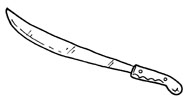
2. TRAIN CONSTANTLY: No matter what weapon you choose, from a simple machete to a semiautomatic rifle, it must become an extension of your body. Practice as often as possible. If classes are available, by all means sign up. Learning from qualified instructors will save immense time and energy. If the device can be disassembled, do so, both in sunlight and total darkness until you know every pin, every spring, every curve and edge of that all-important machine. With practice will come both experience and confidence, two traits you must develop in order to successfully do battle with the living dead. History has proven that a well-trained individual, with nothing but a rock, has a better chance of survival than a novice with the latest technological marvel.
3. CARE FOR YOUR TOOLS: Weapons, no matter how simple they may be, must be cared for as if they were living things. Anyone with firearm experience knows that inspection and cleaning are part of everyday use. This also applies to close-combat weapons. Blades need polish and rust protection. Grips need checking and maintenance. Never abuse your tools or expose them to unnecessary damage. If possible, have them tested regularly by experienced professionals. These experts may detect early-stage defects imperceptible to the amateur user.
4. BEWARE DISPLAY ITEMS: Many companies offer a variety of replica weapons, such as swords, bows, etc., that are meant merely for decoration. Always research your chosen item thoroughly and ensure that it is intended for actual use in the real world. Do not rely solely on the company’s word. “Battle ready” may mean the item could withstand a few blows on a theatrical stage, or at some historical fair, but it will snap in half during a life-or-death confrontation. If resources permit, purchase a duplicate item and train with it to the breaking point. Only then should you trust in its abilities.
5. DEVELOP THE FIRST WEAPON: The human body, if cared for and trained properly, is the greatest weapon on earth. Americans are notorious for their bad diet, lack of exercise, and relentless fetish for labor-saving technology. As recognizable as the term “couch potato” is, a more accurate term would be “cattle”: fat, lazy, listless, and ready to be eaten. Weapon No. 1, the biological tool that is our body, can and must be transformed from prey to predator. Obey a strict diet and physical-fitness regimen. Concentrate on cardiovascular instead of strength-building exercise. Monitor any chronic health conditions you may have, no matter how small. Even if your worst ailment is allergies, treat them regularly! When a situation does arise, you must know exactly what your body is capable of! Study and master at least one martial art. Make sure its emphasis is on escaping holds rather than delivering blows. Knowing how to slip from a zombie’s clutches is the single most important skill you can possess when you find yourself in close combat.
CLOSE COMBAT
Hand-to-hand combat should almost always be avoided. Given a zombie’s lack of speed, it is much easier to run (or walk quickly) than stand and fight. However, it may be necessary to destroy a zombie at close quarters. When this happens, split-second timing is critical. A wrong move, a moment’s hesitation, and you may feel cold hands gripping your arm, or sharp, broken teeth biting into your flesh. For this reason above all, choosing a close-combat weapon is more important than any other in this section.
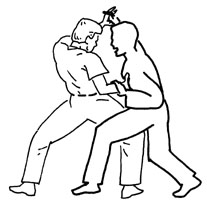
1. BLUDGEONS
When using a blunt weapon, the goal is to crush the brain (remember, the only way to kill a zombie is by destroying its brain). This is not as easy as it sounds. The human skull is one of the hardest, most durable surfaces in nature. So, of course, is the zombie’s. Extreme force is needed to fracture, let alone shatter it. However, this must be done, and done with a single, well-placed blow. Missing your target or failing to breach the bone will leave you with no second chance.

Sticks, ax handles, and other wooden clubs are good for knocking a zombie out of the way or beating off an individual attack. What they lack is the weight and strength necessary for a lethal strike. A section of lead pipe will work for a single encounter but is too heavy for those on the move. A sledgehammer has the same drawback and also requires practice for its user to hit a moving target. Aluminum bats are light enough to work for one, maybe two fights, but are known to bend after prolonged use. The standard, one-handed carpenter’s hammer has striking power but severely limited reach. Its short handle allows a zombie to grab your arm and pull it in. The police baton, made of acetate plastic (in most cases), is strong enough for any battle but lacks the lethal power for a one-blow kill. (Note: This was intended in its design.)

The best bludgeon is a steel crowbar. Its relatively lightweight and durable construction makes it ideal for prolonged close combat. Its curved, semi-sharpened edge also allows for a stabbing motion through the eye socket, directly into the brain case. More than one survivor has reported killing zombies in this manner. Another benefit of the crowbar is that it may be necessary to pry open a door, shift a heavy object, or perform other tasks for which it was originally designed. None of these functions can be accomplished with any of the previously mentioned items. Even lighter and more durable than the steel crowbar is the titanium model, now trickling into Western markets from Eastern Europe and the former Soviet Union.
2. EDGED WEAPONS
Blades, in any form, have advantages and disadvantages over bludgeons. Those that have enough strength to split the skull rarely stand up after many repetitions. For this reason, slicing, particularly decapitation, serves almost the same function as a head blow. (Note: The severed head of a zombie is still able to bite and must be regarded as a threat.) The advantage of slicing over bludgeoning is that it can make killing a zombie unnecessary. In some cases, simply chopping off a limb or severing the spine is enough to disable an undead assailant. (Note: Severing a limb also brings the possibility of contact with the virus through the exposed area.)
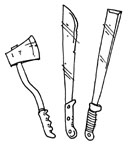
The civilian ax can easily crush a zombie’s skull, smashing through bone and brain in one swing. Decapitation is equally easy, which is why the ax has been the favored tool of executioners for centuries. Connecting with a moving head, however, might be difficult. Furthermore, if the swing ends in a total miss, you might be taken off balance.
The smaller, one-handed hatchet is a good weapon of last resort. If you find yourself cornered, and larger weapons are useless, a hatchet blow will more than take care of an attacker.
The sword is the ideal edged weapon, but not every kind will suffice. Foils, rapiers, and similar fencing weapons are not suited for slicing. Their only possible use would be a direct stab through the eye socket followed by a quick swirling action through the brain. This motion, however, has been accomplished only once, by a trained swordsman, and is therefore not recommended.
Single-handed long swords allow you a free hand for other tasks such as opening a door or defending your body with a shield. Their only drawback is the lack of swinging power. One arm may not have the strength to slice through the thick cartilage between bones. Another drawback is its user’s notorious lack of accuracy. Scoring a flesh wound anywhere on the body of a living opponent is one thing. Making an exact, clean chop through the neck is something else altogether.
Double-handed swords could be considered the best in their class, providing the strength and accuracy for perfect decapitation. Of this type, the Japanese Samurai Katana ranks first. Its weight (three to five pounds) is perfect for long-term conflicts, and its blade can sever the toughest organic fiber.
In tight quarters, shorter blades hold the advantage. The Roman Gladius is one choice, although combat-ready replicas are hard to find. The Japanese Ninjite boasts a two-handed grip and, in genuine models, renowned tempered steel. Both factors make it a superior weapon. The common machete, because of its size, weight, and availability, is probably your best choice. If possible, find the military type usually sold at Army surplus stores. Its steel tends to be of a higher quality, and its blackened blade helps concealment at night.
3. MISCELLANEOUS HAND WEAPONS
Spears, pikes, and tridents serve to skewer a zombie, keeping it out of reach but not necessarily scoring a kill. The chance of an eye-socket stab is possible, but remote. The medieval European halberd (an ax-spear hybrid) may serve as a chopping weapon but, again, requires great amounts of skill and practice to accomplish a decapitating blow. Other than using them as bludgeons, or keeping your attacker at a distance, these weapons serve little purpose.
Morning stars or “flails,” a spiked ball chained to a rod, do basically the same damage as a crowbar, albeit in a more dramatic way. The owner swings the rod in a wide, circular motion, providing enough momentum to bring the ball crashing through the skull of his or her opponent. Using this weapon takes considerable skill, and it is therefore not recommended.
The medieval European mace serves the same function as the standard household hammer but without benefit of the latter’s practical uses. A mace cannot pry open a door or window, drive a chisel, or hammer a nail. Attempting such an act could result in accidental injury. Therefore, carry this medieval weapon only when no alternative is available.
Knives are always useful, serving a variety of functions in a range of situations. Unlike a hatchet, they can kill a zombie only when the blade is stabbed through the temple, eye socket, or base of the skull. On the flip side, knives almost always weigh less than hatchets and, therefore, are better if you are on the move. When choosing a knife, make sure the blade is no more than six inches long and always smooth. Avoid serrated knives and saw-blade combinations found in survival knives, as they tend to become lodged in their victims. Imagine yourself stabbing one zombie through the temple and turning to engage the other three ghouls but not being able to retrieve your blade.
The trench spike is, without a doubt, the best compact anti-zombie weapon on earth. It is a combination of a seven-inch steel spike for a blade and brass knuckles for a handle. It was developed during the vicious hand-to-hand combat of World War I, where soldiers killed each other in trenches no wider than a few feet. Specifically, it was designed to stab downward, through an enemy’s steel helmet. You can imagine how effective this weapon would be against a zombie. The user could stab easily through a zombie’s skull, withdraw cleanly and quickly, then turn to either brain another zombie or, at the very least, knock one over with a brass-knuckle punch to the face. Original models are extremely rare, with barely a few remaining in museums and the homes of private collectors. However, if accurate, detailed schematics can be found, have one or perhaps two combat-ready, stress-tested replicas made. They will be an investment you will never regret.
The Shaolin Spade
This weapon bears special mention in the anti-ghoul arsenal. It may appear unconventional: a six-foot hardwood staff with a flat, bell-shaped blade on one end and an outward-facing crescent blade on the other. Its roots date back to a bronze-bladed agricultural tool used during the Chinese Shang Dynasty (1766–1122 B.C.E.). When Buddhism migrated to China, the spade was adopted by Shaolin monks as both tool and weapon. On several occasions, it has proven to be surprisingly effective against the living dead. Thrusting forward with either blade will produce instant decapitation, while its length provides complete safety for the user. This length does make it impractical for indoor combat, and it should therefore be avoided in those situations. In open spaces, however, nothing combines the safety of a spear with the killing power of a katana sword like the Shaolin spade.

A variety of other hand weapons exist around the world, and space does not permit the author to discuss each one individually. If you discover an implement or tool that you think might make a good weapon, ask yourself these questions:
1. Can it crush a skull in one blow?
2. If not, can it decapitate in said blow?
3. Is it easy to handle?
4. Is it light?
5. Is it durable?
Questions 3, 4, and 5 will have to depend on your present situation. Questions 1 and 2 are essential!

4. POWER TOOLS
Popular fiction has shown us the awesome, brutal power of the chainsaw. Its lightning-quick, rotating teeth can easily slice through flesh and bone, making the strength and skill required for manual weapons unnecessary. Its roar might also give the owner a much-needed psychological boost—empowerment in a situation where abject terror is a given. How many horror movies have you seen in which this industrial killing machine has spelled doom for anyone and anything it touched? In reality, however, chainsaws and similar powered devices rank extremely low on the list of practical zombie-killing weapons. For starters, their fuel supply is finite. Once drained, they provide as much protection as a hand-held stereo. Carrying extra fuel or power cells leads to the second inherent problem: weight. The average chainsaw weighs ten pounds, compared to a two-pound machete. Why increase the chances of exhaustion? Safety must also be considered. One slip, and the spinning teeth might be slicing through your skull just as easily as your enemy’s. Like any machine, another problem is noise. A chainsaw’s distinctive roar, even if running for just a few seconds, will be enough to broadcast to every zombie within earshot, “Dinner is served!”
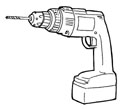
SLINGS AND ARROWS
It is a commonly held notion that using non-firearm ballistics such as bows and slingshots are a waste of energy and resources. In most cases, this is true. However, if used properly, such a weapon will enable you to score a kill at long range with little or no sound. What if you’re attempting to escape an infested area, you turn a corner, and a single ghoul blocks your path? It’s too far away for a hand weapon. Before you get close, its moans will betray your position. The crack of a firearm will sound an even louder alarm. What do you do? In cases like these, certain silent weapons may be your only option.
1. THE SLING
Made famous from the biblical story of David and Goliath, this weapon has been part of our heritage since prehistoric times. The user places a smooth, round stone in the wider center of a thin leather strip, grabs both ends, swings it repeatedly in a rapid circle, then releases one end of the strip, loosing the stone at his target. Theoretically, it is possible to dispatch a zombie with a silent headshot at just under thirty paces. However, even with months of training, the chances of scoring such a hit are one in ten at best. With no experience, the wielder would be better off just throwing stones.
2. THE SLINGSHOT
A descendant of the leather strap, the modern slingshot has at least ten times the accuracy of its ancestor, the sling. What it lacks is punch. Small projectiles fired from a modern slingshot simply do not have the force, even at minimum range, to penetrate a zombie’s skull. Using this weapon might serve only to alert a ghoul to your presence.
3. THE BLOWGUN
Given that poison has no effect on the undead, discount this weapon entirely.
4. SHURIKEN
These small, multipoint devices were used in feudal Japan to pierce a human skull. In appearance they resemble a steel, two-dimensional replica of a shining star, hence their nickname, “throwing stars.” In expert hands, they could easily bring down a zombie. However, as with many weapons discussed, the throwing star requires great expertise. Unless you are one of the few masters of this art (only a handful can still claim this title), refrain from such an exotic method.
5. THROWING KNIVES
As with shuriken, these short-range weapons require weeks of practice to hit something as large as a human body and months to hit something as small as a human head. Only a dedicated expert could even hope for a reliable zombie kill. The time and energy spent training could be much more productive if applied to a conventional weapon. Remember, you have a variety of skills to learn, and not all the time in the world to learn them. Don’t waste those valuable hours attempting to master a third-rate weapon.
6. THE LONG OR COMPOUND BOW
To be blunt, hitting a zombie through the head with an arrow is an extremely difficult feat. Even with compound bows and modern sights, only experienced archers have a chance of making a direct shot. The only practical use for this weapon is the delivery of incendiary arrows. For starting fires silently, at long distance, nothing works better than a flaming arrow. This manner of attack can, and has, been used to set undead individuals on fire. The targeted zombie will not know enough to pull the arrow from its body and might, given the right circumstances, burn other ghouls before succumbing to the flames. (See “Fire,” for appropriate use.)
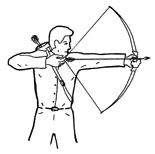
7. THE CROSSBOW
The power and accuracy of a modern crossbow can send a “bolt” (crossbow arrow) clean through a zombie’s skull at over a quarter mile. Small wonder it has been dubbed “the perfect silent killer.” Marksmanship is important, but no more so than with a rifle. Reloading requires time and strength, but this should be unnecessary. The crossbow is a sniper’s weapon, not a crowd-stopper. Use only against one zombie. Any more, and you might find yourself grabbed and mauled before you have time to load another bolt. As for bolts, either triangular or bullet-shape will suffice. For increased accuracy, a telescopic sight should be added. Unfortunately, the size and weight of any good crossbow will make it the primary weapon. Therefore, choose one only when the situation permits, such as traveling in a group, defending your home, or when no silenced firearms are available.
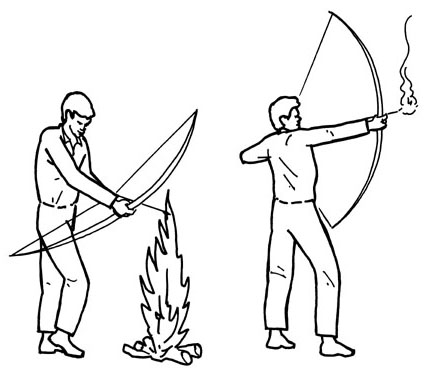
8. THE HAND BOW
Smaller, one-handed crossbows can serve as a complement to your primary weapon. Carrying one means that a compact, silent weapon will always be on hand if needed. In comparison to the larger crossbow, hand bows have inferior accuracy, power, and range. Using one means getting closer to the target. This increases not only the danger but the risk of detection, which, in turn, negates the need for a silent weapon. Use the hand bow carefully, and sparingly.
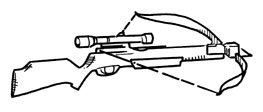
FIREARMS
Of all the weapons discussed in this book, nothing is more important than your primary firearm. Keep it cleaned, keep it oiled, keep it loaded, keep it close. With a cool head, steady hand, and plenty of ammunition, one human is more than a match for an army of zombies.
Choosing a firearm must be an exact science, with every variable considered. What is your primary goal: defense, attack, or flight? What outbreak class are you facing? How many people, if any, are in your group? What environment is your battleground? Different firearms serve different functions. Almost none serve all. Selecting the perfect tools means dispelling conventional doctrines of warfare that have worked so well against our fellow humans. Sadly, we know all too well how to kill each other. Killing zombies—that’s another story.
1. THE HEAVY MACHINE GUN
Since World War I, this invention has revolutionized human conflict. Its mechanism allows a storm of lead to be discharged in seconds. These tactics may be invaluable on the human battlefield but are a feckless waste against the living dead. Remember, you are going for a head shot: one bullet, precisely placed. As the machine gun is designed for saturation fire, it may take hundreds, even thousands of rounds for one, randomly lethal shot. Even aiming the machine gun as a rifle (a tactic used by U.S. special forces) is a losing proposition. Why hit a zombie with a well-aimed five-round burst when one well-aimed rifle shot produces the same result? In the 1970s, one school of thought favored the “scythe theory”: If a machine gun is placed at the head level of an undead crowd, it could mow them down with one long burst. This argument has been debunked—ghouls, like the humans they used to be, are not all the same height. Even if some are destroyed, at least half will survive to close on your position. But what about the massive body damage caused by these weapons? Won’t a machine gun have enough punch to rip a body in half, and doesn’t that negate the need for a head shot? Yes and no. The standard 5.56-millimeter round used by the U.S. Army SAW (Squad Automatic Weapon) does have the ability to snap a human spine, sever limbs, or yes, tear a zombie’s form in two. This, however, does not mean a head shot is unnecessary. For one, the chance of dismembering a zombie is slight and therefore requires large amounts of ammunition. For another, unless the brain is destroyed, the zombie itself is still alive—crippled, yes, perhaps even immobile, but still alive. Why give yourself the unnecessary need of having to finish off a mass of writhing and potentially dangerous body parts?
2. THE SUBMACHINE GUN
The problem presented by this weapon is similar to that of the heavy machine gun: ammo expended versus living dead dispatched. However, when fighting in tight quarters, the submachine gun finds its niche. The short barrel makes it easier to handle than a rifle, but the folding stock gives it much more support than a pistol. Always be sure to keep it on the single-shot setting. As we discussed, full auto is simply a waste of ammo. Also, be sure to aim it from the shoulder. Shooting from the hip will produce nothing more than a loud noise and a clean miss. One disadvantage is poor accuracy at long range. Because the submachine gun was designed as a close-combat weapon, you will have to get much closer to a zombie than if you were carrying a rifle or assault weapon. This would normally not be a problem except that submachine guns, like all auto and semiautomatic weapons, have the possibility of jamming while in use. At short range, you may be putting yourself at unnecessary risk. This is the only reason to discount a submachine gun as your primary weapon.
3. THE ASSAULT RIFLE
This weapon was invented originally to bridge the gap between the rifle and submachine gun, offering both range and rapid fire. Wouldn’t these traits make it ideal against the undead? Not really. Although range and accuracy are needed, rapid fire, as we’ve seen, is not. Even though an assault rifle can be set for semiautomatic, just like a submachine gun, the temptation to go full auto still exists, as it does with a submachine gun. When fighting for your life, it may simply be too easy to flip the switch to “rock ’n’ roll,” no matter how wasteful and useless this might be. If you do choose an assault rifle as your primary weapon, keep in mind the basic questions that apply to all firearms: What is its range? What is its accuracy? Is the appropriate ammunition readily available? How easy is it to clean and maintain?
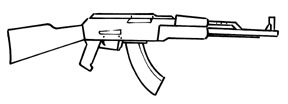
To answer some of these questions, it is best to examine two extreme examples. The U.S. Army M16A1 is considered by many to be the worst assault rifle ever invented. Its overcomplicated mechanism is both difficult to clean and prone to jamming. Adjusting the sight, something that must be done every time a target shifts its range, requires the use of a nail, ballpoint pen, or similar device. What if you didn’t have one, or lost it as several dozen zombies shambled steadily toward you? The delicate plastic stock of the M16A1 obviates bayonet use, and by attempting to use it as such you would risk shattering the hollow, spring-loaded stock. This is a critical flaw. If you were confronted by multiple ghouls and your A1 jammed, you would be unable to use it as a last-ditch hand-to-hand weapon. In the 1960s, the M16 (originally the AR-15) was designed for Air Force base security. For political reasons typical of the military-industrial complex (you buy my weapon, you get my vote and my campaign contribution), it was adopted as the principal infantry weapon for the U.S. Army. So poor was its early battle record that during the Vietnam War, communist guerrillas refused to take them from dead Americans. The newer M16A2, although somewhat of an improvement, is still regarded as a second-class weapon. If given the choice, emulate the Vietcong and ignore the M16 entirely.
On the opposite end of the spectrum, the Soviet AK-47 is considered the best assault rifle ever made. Although heavier than the M16 (10.58 pounds versus 7 pounds) and possessing a considerably harder kick, this weapon is famous for its rugged efficiency and sturdy construction. Its wide, spacious firing mechanism prevents jamming from dirt or sand. In hand-to-hand combat, you could either stab a zombie through the eye socket with the weapon’s bayonet or use the solid, steel-backed wooden stock to smash through a zombie’s skull. If imitation is the sincerest form of flattery, then several nations have chosen to flatter the AK with either direct copies (Chinese Type 56) or modified designs (Israeli Galil). Again, although the assault rifle is not ideal for defense against the living dead, a member of the AK-47 family will be your best bet.
4. THE BOLT-/LEVER-ACTION RIFLE
A product of the mid-nineteenth century, these weapons are often regarded as obsolete. Why use a hunting rifle when you can own a submachine gun? Such arrogance is simply unfounded, its roots based in techno-chauvinism and the absence of practical experience. A well-made, expertly used bolt- or lever-action rifle offers a defense against the living dead that is as good if not better than the latest military hardware. A rifle’s single-shot capability forces the user to make each round count, increasing the chance of a hit. This feature also eliminates even the possibility of “rock ’n’ rolling,” and therefore preserving ammunition whether the user intends to or not. A third reason is the relative easiness to clean and operate a rifle, something that must not be overlooked. Hunting rifles are designed for a civilian market. Manufacturers know that if they are too complex, sales will plummet. A fourth and final reason is ready availability of ammunition. As there are more civilian gun shops than military armories in the United States (a pattern not shared by the rest of the world), you will find it easier to obtain ammunition for a hunting rifle than an assault weapon or submachine gun. This will prove critical in any of the scenarios covered in the latter part of this manual.
When choosing a bolt- or lever-action rifle, try to find an older, military version if possible. This does not mean that civilian models are inferior weapons—quite the opposite—but almost all military bolt-action rifles were designed for use in hand-to-hand combat. Make sure you take the time to study the use of a rifle for this purpose. Simply swinging it like a club would destroy any weapon, military and civilian alike. Manuals are available that explain how to use a rifle as a bludgeon. Even old war films can demonstrate how deadly these weapons are without firing a shot. Examples of bolt-action military rifles are the U.S. Springfield, the British Lee Enfield, and the German Mauser Kar 98k. Many of these still exist, some in good working order. Before choosing, however, make sure the appropriate ammunition is in ready supply. Having an impressive, bolt-action military rifle will do no good if the only rounds available fit civilian models.
5. THE SEMIAUTOMATIC RIFLE
Since its debut, this weapon has shown itself to be a superior zombie killer. Given the possibility of wasting ammunition (a round is expended every time the trigger is pulled), a fair amount of discipline is required. However, this option can be a blessing when engaging multiple targets. In one recorded instance, a trapped woman dispatched fifteen attacking zombies in twelve seconds! (See “1947 A.D., Jarvie, British Columbia.”) This story illustrates the potential of a semiautomatic rifle. For close combat or for people on the run, the semiautomatic carbine serves the same function as the larger model. Although possessing half the range, the carbine tends to be lighter and easier to carry, and uses smaller ammunition. Either type will serve you well, depending on the situation. When choosing a semiautomatic weapon, the World War II M1 Garand or M1 Carbine are, in many ways, superior to contemporary weapons. This may be surprising, but these older military weapons were designed to survive the greatest conflict in history. Not only did they meet this task admirably, but the Garand remained the U.S. Army’s main rifle through the Korean conflict, while the Carbine saw action up until the first years of Vietnam. Another advantage of the M1 Garand is its secondary role as a hand-to-hand weapon (in WWII, bayonet use was still considered a vital part of combat). Although no longer in production, many Garands still remain on the market with ammunition widely available. The M1 Carbine is, amazingly, still in production. Its light weight and short muzzle perfectly suit this weapon to indoor combat or long journeys on foot. Other, more modern choices include the Ruger Mini-30, Ruger Mini-14, and the Chinese Type 56 (a copy of the Soviet SKS carbine, not to be confused with the assault rifle of the same name). If discipline can be maintained, you will not find a better weapon than the semiautomatic rifle.

6. THE SHOTGUN
At close range against human attackers, this weapon reigns supreme. Against the living dead, this is not entirely true. A good twelve-gauge shotgun can literally blow a zombie’s head off. However, the longer the range, the greater the pellet dispersal pattern, and the lesser chance of skull penetration. A solid slug would have the same effect as a rifle, even at greater range (provided the barrel is long enough), but in that case, why not just use a rifle? What shotguns do possess is stopping power. The scattering shot acts as a solid wall, whereas a rifle bullet might pass clean through or miss the target altogether. If you are cornered, or on the run, and need time to escape, a good shotgun blast can send several zombies sprawling. The downside of a shotgun is that the large, twelve-gauge shells are bulky and therefore burdensome when traveling and leave less room for other equipment. This must be considered if a long journey is required.
7. THE PISTOL
Americans have a special relationship with handguns. They seem to appear in every movie, every TV show, every pop novel, every comic book. Our heroes have always carried them, from the Old West lawman to the gritty urban cop. Gangsters rap about them; liberals and conservatives fight over them. Parents shelter children from them and manufacturers make untold fortunes from them. Possibly more than the automobile, the handgun is synonymous with America. But how useful is this cultural icon against a swarm of newly risen flesh-eaters? In truth, not very. Unlike our fictional heroes, the average person may have difficulty hitting anything, let alone something as small and mobile as a zombie’s head. Throw in the obvious emotional strain of undead combat, and the possibility of a successful shot ranks one step above negotiating with your attacker. Studies have shown that of all wasted ballistic wounds—e.g., those that struck a zombie in a non-lethal way—73 percent came from some type of handgun. A laser sight increases the odds of accurate aim but does nothing to steady a shaky wrist. Where handguns do come in handy is in extreme circumstances. If you are grabbed by a zombie, a pistol can be a life-saver. Pressing its muzzle against the undead temple and squeezing the trigger takes no skill and ensures a positive kill. The fact that handguns are small, light, and easy to carry make them attractive as a secondary weapon for any scenario. If your primary weapon is a carbine, this adds the possibility of shared ammo and lighter load. For these reasons, a pistol should always be carried when confronting ghouls, but as a backup only. Never forget that many dismembered, half-eaten corpses have been discovered with these wonder weapons still clutched in their cold, dead hands.

8. .22-CALIBER RIMFIRE WEAPONS
These weapons (rifle or pistol) fire a round no wider than a few millimeters and no longer than an inch. In normal circumstances it is usually relegated to practice, competition, or the hunting of small game. In an attack by the undead, however, the diminutive .22 rimfire stands proudly alongside its heavier cousins. The small size of its rounds allows you to carry three times as much ammunition. This also makes the weapon itself lighter, a godsend on long treks through ghoul-infested territory. The ammunition is also easy to manufacture and plentiful throughout the country. No shop that sells any kind of ammunition would fail to stock .22 rimfire. Two disadvantages present themselves, however, when the use of a .22 is considered. The small round has zero stopping power. People (including former President Reagan) have been shot with .22s and not even realized it until later. A ghoul taking a round to the chest would not even be slowed, let alone stopped, by this puny projectile. Another problem is the lack of skull penetration at longer ranges. With a .22, you might have to get a little too close for comfort, a fact that could increase stress and degrade the odds of a kill. By the same token, the lack of power in a round fired by a .22 has been called a blessing in disguise. Without the force to punch through the back of a zombie’s skull, .22 bullets have been known to ricochet inside the brain case, doing as much damage as any .45. So when it comes time to arm yourself against a looming zombie menace, do not discount the small, almost toylike nature of this nimble, efficient firearm.

9. ACCESSORIES
Silencers, if attainable, can be a vital attachment to your firearm. Their ability to muffle noise obviates the need for a bow, sling, or other non-ballistic weapon (essential if on the move).
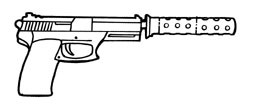
A telescopic sight can increase aim immeasurably, especially for long-range sniper attacks. Laser sights, on the surface, may be your best bet. After all, how hard is it to place a red dot on a ghoul’s forehead? The disadvantage is limited battery life. The same goes for night-vision scopes. Although they allow for accurate, long-range hits on zombies after dark, they become nothing more than useless black tubes when the power runs out. Conventional glass and metal sights are the preferable accessory. They may not be fancy, and they may lack the cachet of electronics, but these basic instruments will never let you down.
RANGE versus ACCURACY
Studies have shown that, given the trauma of battle, the closer a human is to a zombie, the wilder his shooting will be. When practicing with your firearm(s), establish a maximum range for repeated accuracy. Practice against moving targets in ideal (stress-free) conditions. Once that range is fixed, divide it by half. This will be your effective kill zone during an actual attack. Make sure the undead do not move closer than this zone, as your accuracy will erode. If engaging a group, make sure to hit those that enter the zone first before dispatching the others. Do not discount this advice no matter what your previous experience has been. Street-hardened police officers, decorated combat veterans, even “cold-blooded” murderers have ended up as well-chewed meat because they believed in their “nerves” and not their training.
EXPLOSIVES
Question: What could be better than hurling a hand grenade at a mass of approaching zombies? Answer: almost anything. Anti-personnel explosives kill mainly by shrapnel, metal shards tearing through vital organs. As this will not affect zombies, and the chance of shrapnel penetrating the skull is slim, grenades, bombs, and other explosive tools are inefficient weapons.
These devices should not be completely discounted, though. For blasting through doors, creating instant barricades, or even scattering zombie mobs, nothing works better than a jar of gunpowder.
FIRE
The living dead have no fear of fire. Waving an open flame in a ghoul’s face will do nothing to slow or impede its advance. Zombies who have caught fire will neither notice nor react to the engulfing flames in any way. Too many humans have met with tragedy for failing to understand that fire is no deterrent to zombies!
As a weapon, however, fire is still humanity’s greatest ally. Complete incineration is the best way to destroy a zombie once and for all. Burning eliminates not only the body but all traces of Solanum. However, don’t think a flamethrower and several Molotov cocktails are the solution to all your problems. In actual combat, fire can be as deadly a threat as it is a protector.

Flesh—human, undead, or otherwise—takes a long time to burn. In the minutes or hours before a blazing zombie succumbs, it will become a walking—or to be perfectly accurate, a shambling—torch. Several cases have been recorded in which burning ghouls have done more damage, even caused more deaths, than they would have with only their fingernails and teeth.
Fire itself has no loyalty. Consider the flammable nature of your surroundings, the chance of smoke inhalation, the possibility that a blaze will act as a beacon for other zombies. All these factors must be considered before such a powerful and unpredictable weapon is unleashed.
For this reason, fire is mainly considered an attack or flight weapon, and rarely used for static defense.
1. MOLOTOV COCKTAILS
This term applies to any jar of flammable liquid with a primitive fuse. It is a cheap, effective way to kill multiple zombies at once. If the situation permits—e.g., fleeing an advancing horde, clearing a fireproof structure, or destroying a flammable structure with multiple zombies trapped in it—by all means, bombard the ghouls in question until nothing is left but ash.
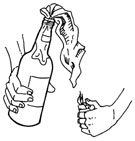
2. DOUSING
The act of dousing consists of simply filling a bucket with flammable liquid (gasoline, kerosene, etc.), throwing it at a zombie or zombies, lighting a match, and running. If there is room for escape and no danger of residual fire damage, the only drawback to this method is the close proximity required to fully drench the enemy.

3. THE BLOWTORCH
The common torch, which consists of a propane tank attached to a nozzle, has neither the heating power nor the fuel supply to burn through a zombie skull. But it can be a convenient firestarter if the undead in question have already been soaked in a flammable liquid.
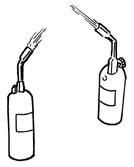
4. THE FLAMETHROWER
This device, perhaps more than any other, strikes people as the ultimate zombie eliminator. A jet of flame, two hundred feet long, composed of jellied gasoline, can turn an undead crowd into a wailing funeral pyre. So why not acquire one? Why not forsake all other weapons for this man-made fire-breathing dragon? The answers are as realistic as they are numerous. The flamethrower was developed purely as a military weapon and is no longer in service with the U.S. Army and Marine Corps. It would be difficult to find any model, let alone one that works properly. Acquiring the fuel is even more difficult than the thrower. But assuming you can find both, you must consider its practical use. Why carry seventy pounds of equipment on your back when only a handful of ghouls are loose? A flamethrower’s weight makes it a liability if you are on the move. Unless you are in a fixed position or have access to motorized transport, sheer exhaustion will become as dangerous a threat as the walking dead. Common sense would suggest that a flamethrower’s place on the battlefield is against overwhelming numbers, swarms of undead numbering in the hundreds if not thousands. If such a horde were, heaven forbid, to exist, chances are they would be facing a much larger, well-equipped government force rather than one private citizen and his trusty (and let’s not forget illegal) flamethrower.
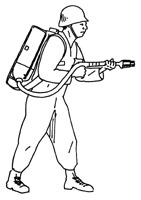
OTHER WEAPONS
Imagination and improvisation are two invaluable assets during clashes with the living dead. By all means, feel free to regard all the materials around you as a cache of potential weapons. But always keep in mind a zombie’s physiology, and what your homemade device is likely to accomplish.
1. ACID
Apart from fire, sulfuric acid is the best way to completely destroy a zombie. Implementing it is another matter. If somehow you have the means to acquire or produce large amounts of sulfuric acid, treat it with the same respect you would an incendiary weapon. Not only is this substance as much a danger to yourself as it is to the undead, the time it takes to dissolve zombie flesh and bone is considerable. Acid should be used as a post-encounter disposal tool rather than a combat weapon.

2. POISON
As there are hundreds of thousands of lethal compounds in this world, it is impossible to discuss them all. Instead, we will review some basic rules that govern the physical and physiological makeup of the undead. Zombies are immune to all types of tranquilizers and irritants such as Mace and tear gas. Any compound designed to halt bodily functions would be equally impotent, as the undead no longer require these functions. Zombies do not suffer from heart attacks, nerve paralysis, suffocation, or any other fatal effects caused by poison.
3. BIOLOGICAL WARFARE
Wouldn’t it be poetic to destroy beings infected by a virus with another virus? Unfortunately, this is not an option. Viruses attack only living cells. They have no effect on the dead. The same is true for all types of bacteria. Several laboratory attempts have been made to culture and spread necrotizing fasciitis (a flesh-eating bacterial disease) among captured zombies. None have proved successful. Experiments are now under way to grow a new strand of bacterium that feeds only on dead flesh. Most experts are skeptical of its success. Tests are ongoing to determine which of the many microorganisms normally involved in decomposition continue to consume flesh in spite of its infected nature. If these microbes can be isolated, reproduced, and delivered in a manner not harmful to its user, they could be humanity’s first weapon of mass destruction in the battle against the living dead.

4. ZOOLOGICAL WARFARE
Hundreds of creatures, great and small, feed on carrion. Employing some of these animals to devour the dead before they devour the living might seem the ideal solution. Unfortunately, all species, from hyenas to fire ants, instinctively avoid zombies. The highly toxic nature of Solanum appears to be encoded in the survival patterns of the animal kingdom. This mysterious warning signal that Solanum emits, be it an odor or some kind of “vibe” long forgotten by humans, is impossible to mask by any known substance. (See “1911 A.D., Vitre, Louisiana.”)
5. ELECTROCUTION
As the zombie’s muscular system is basically that of a human, electricity does have the ability to temporarily stun or paralyze its body. Lethal results have been seen only in extreme cases such as power lines used to completely char a zombie’s brain. This is not a “wonder weapon”—the current that runs through power lines is enough to burn almost any organic matter, living or undead, to a crisp. It requires twice the voltage to stun a zombie that it does to stun a human, so common taser guns are ineffective. Electricity has been used to create a temporary barrier with water-filled, electrified ditches to keep ghouls paralyzed long enough for a secondary fatal method to be employed. Several such incidents have been recorded over the years.
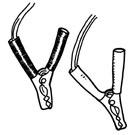
6. RADIATION
Experiments are now being conducted to test the effects of microwaves and other electromagnetic signals on the brains of the undead, on the theory that such a device could generate massive, instant, lethal tumors in a zombie’s gray matter. Research is still in its early stages, and results have so far been inconclusive. The only known instance when zombies came into contact with gamma radiation occurred during the notorious Khotan Incident. (See “1987 A.D., Khotan, China.”) In this event, the ghouls were not only unaffected by rads that would have killed humans, but they threatened to spread their contamination throughout the province. For the first time, the world glimpsed a new and even deadlier threat: the radioactive zombie. As much as this sounds like the product of bad 1950s science fiction, it is, or was, a very real and historically significant fact. According to records, the radioactive ghouls possessed no enhanced abilities or magical powers. The threat they posed lay in their ability to spread deadly radiation to everything and everyone they touched. Even people who drank from a water supply the ghouls had touched died soon afterward from radiation sickness. Fortunately, the outbreak was crushed by the overwhelming power of the Chinese army. Not only did this solution put an end to this new danger—it prevented the disaster of the Khotan reactor going critical.

7. GENETIC WARFARE
Some recent proposals recommend a variety of genetic weapons in the war against the undead. The first step would be to map the genetic sequence of Solanum. Next, an agent would be developed to rewrite that sequence, ordering the virus to suspend its attack on human tissue, turn on itself, or simply self-destruct. Instead of retraining the zombie, we would retrain the virus that controls the zombie. If successful, any of these agents would be a revolutionary breakthrough in combating the undead. Through genetic engineering we could find an actual cure. Celebration of this breakthrough, however, will have to wait. The science of genetic therapy is still in its infancy. Even with media attention and massive financial resources, both of which are nonexistent, an agent to combat the virus will have to remain a theory.
8. NANOTHERAPY
Nanotechnology, the study of microscopic machinery, is only in its adolescence. At present, experimental computer chips are being made that are no bigger than a molecule! One day robots that small will be able to perform tasks within the human body. These nanobots, or whatever the accepted term will be, will one day destroy cancer cells, repair damaged tissue, even attack and destroy hostile viruses. Theoretically, there is no reason why they could not be injected by the billions into a recently infected human to identify the Solanum virus and eradicate it from the system. When will this technology be perfected? When will it find its way into the medical profession? When will it be adapted for combating Solanum? Only time will tell.
ARMOR
Speed and agility should be your first defense against the walking dead. Armor will not only decrease both these advantages that you have over zombies, but it will also sap your energy during prolonged conflict. Add the risk of dehydration, and the prospect seems even less attractive. One final, less obvious disadvantage to armor is not physical but psychological: People wearing protective garb tend to feel more confident and therefore take greater risks than those in simple clothing. This artificial bravery has resulted in too many senseless deaths. Simply put, the best protection from a zombie bite is distance. If for some reason you insist on some type of protective gear, the follow-ing summary will provide all the information necessary for prudent decision-making.
1. PLATE MAIL
This could be defined as the classic “suit of armor.” The term itself conjures up images of seemingly invincible knights dressed from head to toe in shining steel. With so much protection, wouldn’t one be able to wander among the undead ranks, taunting them at will with no danger of repercussion? In truth, standard medieval armor is far from invulnerable. The leather or metal joints that hold its many pieces together can be torn apart by an individual’s persistent hands, to say nothing of a mob. Even intact, steel suits are heavy, cumbersome, suffocating, dehydrating, and extremely noisy. If possible, study and wear a real suit of armor and practice fighting in it against even one (mock) attacker. You will find the experience uncomfortable at best, excruciating at worst. Now imagine five, ten, fifty attackers, all converging on your position, grabbing at the plates, pulling them in all directions. Without the speed to outrun them or the agility to avoid them, even the necessary vision to find and strike them, you will almost certainly end up as little more than canned food.

2. CHAIN MAIL
If worn from head to toe, this simpler form of armor actually does provide some protection from zombie bites. Teeth will be unable to penetrate its links, thereby saving you from infection. Its flexibility allows for greater movement and speed; its lack of a faceplate allows for greater visibility. Its very nature (unlike solid plates) allows the skin to breathe and thereby cuts down on dehydration and overheating. Drawbacks, however, are still plentiful. Unless you have been training with this armor for years, your combat effectiveness is bound to be impaired. Its weight can still increase exhaustion. Its general discomfort can lead to unwanted distraction, something that must be avoided in battle. Although chain mail may keep you safe from infection, the pressure of a zombie bite may still be enough to crack bones, tear muscles, or rip flesh within the armor. As with plate mail, the clanking of so many chain links will signal to any nearby zombies that prey has arrived. Unless you want your presence announced, discount this idea entirely. On a practical note, if you choose chain mail, make sure it is battle-quality! Much of the medieval or ancient armor produced today is for decoration or stage performance. For this reason, less expensive alloys are used in their production. When purchasing your chain mail, always ensure, through inspection and careful testing, that it can withstand a zombie’s bite.

3. THE SHARK SUIT
Although designed for protection against shark bites, this mesh bodysuit can stand up to the toughest undead jaws. Made of either high-tensile steel or titanium, it provides twice the protection of chain mail with half the weight. Noise, however, is still a factor, as well as physical discomfort and decreased speed and agility. Shark suits might come in handy if hunting the dead underwater. (See “Underwater Battles.”)
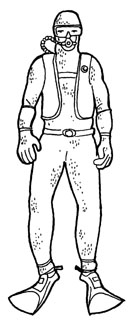
4. HELMETS
This type of armor would be invaluable to ghouls, if only they knew enough to wear them. To humans, they serve no purpose other than obstructing vision. Unless your battle is taking place in a “hard hat area,” avoid this cumbersome waste of space.
5. BULLETPROOF VESTS
Because almost all combat-related zombie bites occur on the limbs, this and other torso armor are a total waste of time. One might consider a bulletproof vest only in a chaotic situation in which there is a chance of being shot by your own people. Even in this situation, the misguided sniper would probably be going for a head shot.
6. KEVLAR COVERS
In recent years, law enforcement have begun to equip officers with this light, ultra-strong material. While thicker, harder plates are used in vests to stop bullets, a thinner, more flexible version is employed to stop blades and the occasional guard dog. This new version, if covering the lower legs and forearms, can help to reduce the risk of zombie bites in close-quarter situations. If you do acquire Kevlar covers, make sure to wear them only during battle, and do not draw any false bravery from them! Many humans in the past have believed that Kevlar or similar kinds of body armor gave them carte blanche to take unnecessary risks. No armor in the world can protect a human from that kind of stupidity. As stated before, your goal is to survive, only survive, and never be a hero. Bravado in combat is the surest way to endanger yourself and those around you!
7. TIGHT CLOTHES AND SHORT HAIR
Cold, hard figures have shown that when battling the living dead, nothing has saved more victims than basic, tight clothing and closely cropped hair. The simple fact is that ghouls attack by reaching out to grab their victims, pulling them in, then biting. Logic dictates that the less material a person offers up for grabs, the better his or her chances will be. Baggy clothing, complete with pockets, straps, or anything that might hang freely, will be a convenient handle for grasping zombie claws. Anyone who has worked in factories or with some kind of heavy machinery will tell you the importance of never letting anything hang loose. Tight clothing, obviously within comfort limits, will help to eliminate this danger. Hair can be a similar hazard. Many times, victims have been seized and even dragged by their hair to a gruesome end. Tying one’s hair back before a conflict may work temporarily. However, a short haircut, one inch or shorter, is ideal for hand-to-hand combat.
